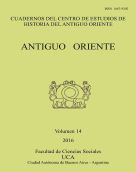Por favor, use este identificador para citar o enlazar este ítem:
https://repositorio.uca.edu.ar/handle/123456789/7509| Título: | Reconsidering the authenticity of the Berekhyahu Bullae : a rejoinder Reconsiderando la autenticidad de los Bullae de Berekhyahu : una réplica |
Autor: | van der Veen, Pieter G. Deutsch, Robert Barkay, Gabriel |
Palabras clave: | HISTORIA; PALEOGRAFIA; JUDAISMO; NUMISMATICA; TRATADOS | Fecha de publicación: | 2016 | Editorial: | Pontificia Universidad Católica Argentina. Facultad de Ciencias Sociales. Centro de Estudios de Historia del Antiguo Oriente | Cita: | Veen, P.G., Deustch, R., Barkay, R. Recondisdering the authenticity of the Berekhyahu Bullae : A Rejoinder [en línea]. Antiguo Oriente. Cuadernos del Centro de Estudios de Historia del Antiguo Oriente. 2016, 14 Disponible en: https://repositorio.uca.edu.ar/handle/123456789/7509 | Resumen: | Abstract: In a recent article Goren and Arie (2014) concluded that the two unprovenanced bullae of Berekhyahu the Scribe “are modern creations, reflecting a se ries of technological misconceptions, anachronisms, and technological errors.” Both bullae were impressed by the same seal and contain the Palaeo-Hebrew inscription: LBRKYHW BN NRYHW HSPR, i.e. “Belonging to Berekhyahu, Son of Neriyahu, the Scribe.” Their use is confirmed by the imprints of material texture and cords on their reverse sides. Having previously studied the bullae, and having recently reexamined “Bulla 1” in particular, the current authors have come to the conclusion that the arguments presented by Goren and Arie do not stand up to scrutiny. Naturally, this does not prove the authenticity of these bullae. In addition they also respond to epigraphic questions raised by Rollston (2003; 2016) which they believe do not stand up to close scrutiny either. What can be said is that the last word has not been spoken. Regardless of the fact that the bullae lack provenance, the very fact that they refer to a well-known biblical character (the scribe Baruch) necessitates a fair examination. Resumen: en un artículo reciente, Goren y Arien (2014) concluyeron que los dos bullae sin procedencia del escriba Berekhyahu “eran creaciones modernas, reflejando una serie de conceptos tecnológicos falsos, anacronicos y errores tecnológicos”. Ambos bullae estaban impresos por el mismo sello y contenían la inscripción paleo-hebrea: LBRKYHW BN NRYHW HSPR, i.e. “Perteneciente a Berekhyahu, hijo de Neriyahu, el escriba”. Su uso está confirmado por las impresiones de material texturado y cuerdas en los reversos. Habiendo estudiado previamente los bullae, y reexaminado recientemente el “Bulla 1” en particular, los autores de este artículo llegan a la conclusión de que los argumentos presentados por Goren y Arie no resisten el escrutinio. Naturalmente, esto no prueba la autenticidad de estos bullae. Además, también responden a los problemas epigráficos postulados por Rollston (2003; 2016), las cuales tampoco resisten mayores escrutinios. Lo que se puede decir es que no se ha dicho la última palabra. A pesar del hecho de que los bullae carecen de procedencia, el mismísimo hecho que estos refieren a un conocido personaje bíblico (el escriba Baruch) necesita un examen justo. |
Cobertura Espacial: | MESOPOTAMIA | URI: | https://repositorio.uca.edu.ar/handle/123456789/7509 | ISSN: | 1667-9202 | Disciplina: | HISTORIA | Derechos: | Acceso Abierto | Fuente: | Antiguo Oriente. Cuadernos del Centro de Estudios de Historia del Antiguo Oriente. 2016, 14 |
| Aparece en las colecciones: | AO - 2016 vol. 14 |
Ficheros en este ítem:
| Fichero | Descripción | Tamaño | Formato | |
|---|---|---|---|---|
| authenticity-berekhyahu-bullae.pdf | 590,91 kB | Adobe PDF |  Visualizar/Abrir |
Visualizaciones de página(s)
155
comprobado en 30-abr-2024
Descarga(s)
365
comprobado en 30-abr-2024
Google ScholarTM
Ver en Google Scholar
Este ítem está sujeto a una Licencia Creative Commons

